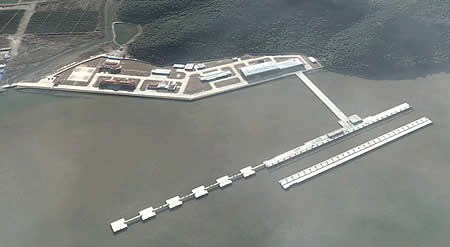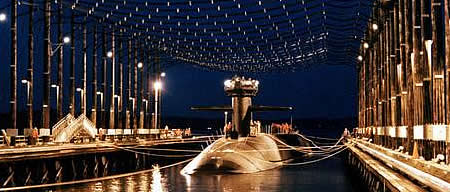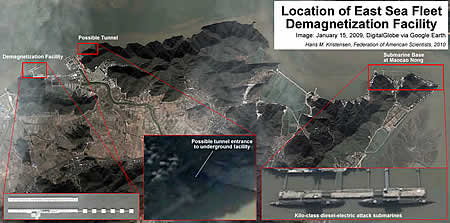Second Chinese Naval Demagnetization Facility Spotted
 |
| Click image for large version |
.
By Hans M. Kristensen
The Chinese navy has constructed what appears to be a demagnetization facility near an East Sea Fleet submarine base.
The facility is the second spotted at Chinese naval bases since 2008.
Chinese Naval Demagnetization Facilities
The new demagnetization facility is located less than 10 km from the Kilo submarine base at Maocao Nong approximately 40 km southeast of Ningbo in the Zhejiang province.
Seven Kilo-class submarines were visible at the base on January 15, 2009, nearly a third of the roughly 19 diesel-electric attack submarines that are deployed with the East Sea Fleet.
.
The East Sea Fleet facility was built between August 2007 and March 2008.
The East Sea Fleet facility is the second known Chinese demagnetization facility. In April 2008, I identified the first such facility at the South Sea Fleet base near Yulin on Hainan Island.
The South Sea Fleet facility was constructed sometime between January 2006 and February 2008.
.
The two demagnetization facilities are similar but with differences. The South Sea Fleet facility is built in a c-shape, similar to the U.S. design. The East Sea Fleet facility, which is located in a river, consists of two parallel piers, perhaps to accommodate strong currents.
The Purpose of Demagnetization
Demagnetization is conducted before deployment to remove residual magnetic fields in the metal of a vessel to make it harder to detect by other submarines and surface ships. It reduces the ship’s vulnerability to mines that are triggered by magnetic signals from metal hulls. Demagnetization apparently also can improve the speed of the vessel.
| Demagnetization of Ballistic Missile Submarine |
 |
| A U.S. SSBN is prepared for demagnetization at the Kitsap Naval Submarine Base near Bangor, Washington. The U.S. Navy has such facilities on both coasts. |
.
Both submarines and surface ships are demagnetized at regular intervals.
Nuclear-powered submarines including SSBNs are based at the North Sea and South Sea Fleets, but not at the East Sea Fleet. I suspect that we’ll see construction of a North Sea Fleet demagnetization facility soon.
Some Implications
Occasional Chinese naval force operations get prominent attention in western news media, such as the recent transit between Okinawa and Miyako Island of eight destroyers and two submarines. Routine operations by U.S. forces, on the other hand, are rarely described except when they involve large exercises or when incidents occasionally expose secret options such as the Impeccable incident in 2009.
Mining of harbors and costal areas would likely be an important mission for both U.S. and Chinese attack submarines and anti-submarine warfare forces in a hypothetical military conflict between China and the United States. Chinese naval forces have, despite ongoing modernization, significant technological and operational deficiencies.
So why has China not constructed naval demagnetization facilities earlier? After all, other naval powers have done so for decades after German engineers during World War II invented the magnetic mine. According to one report, China appears to have used degaussing vessels rather than fixed facilities.
Perhaps construction now reflects acquisition of new technology, a decision that fixed facilities are more efficient than degaussing vessels, or that modifications to China’s naval strategy make demagnetization more important.
Whatever the motivation, the construction of demagnetization facilities at China’s fleets are clear tell-signs of the cat-and-mouse game that is in full swing in the region between the naval forces of China and the United States and its Asian allies.
This publication was made possible by a grant from Carnegie Corporation of New York and Ploughshares Fund. The statements made and views expressed are solely the responsibility of the author.
While it is reasonable for governments to keep the most sensitive aspects of nuclear policies secret, the rights of their citizens to have access to general knowledge about these issues is equally valid so they may know about the consequences to themselves and their country.
Nearly one year after the Pentagon certified the Sentinel intercontinental ballistic missile program to continue after it incurred critical cost and schedule overruns, the new nuclear missile could once again be in trouble.
“The era of reductions in the number of nuclear weapons in the world, which had lasted since the end of the cold war, is coming to an end”
Without information, without factual information, you can’t act. You can’t relate to the world you live in. And so it’s super important for us to be able to monitor what’s happening around the world, analyze the material, and translate it into something that different audiences can understand.

